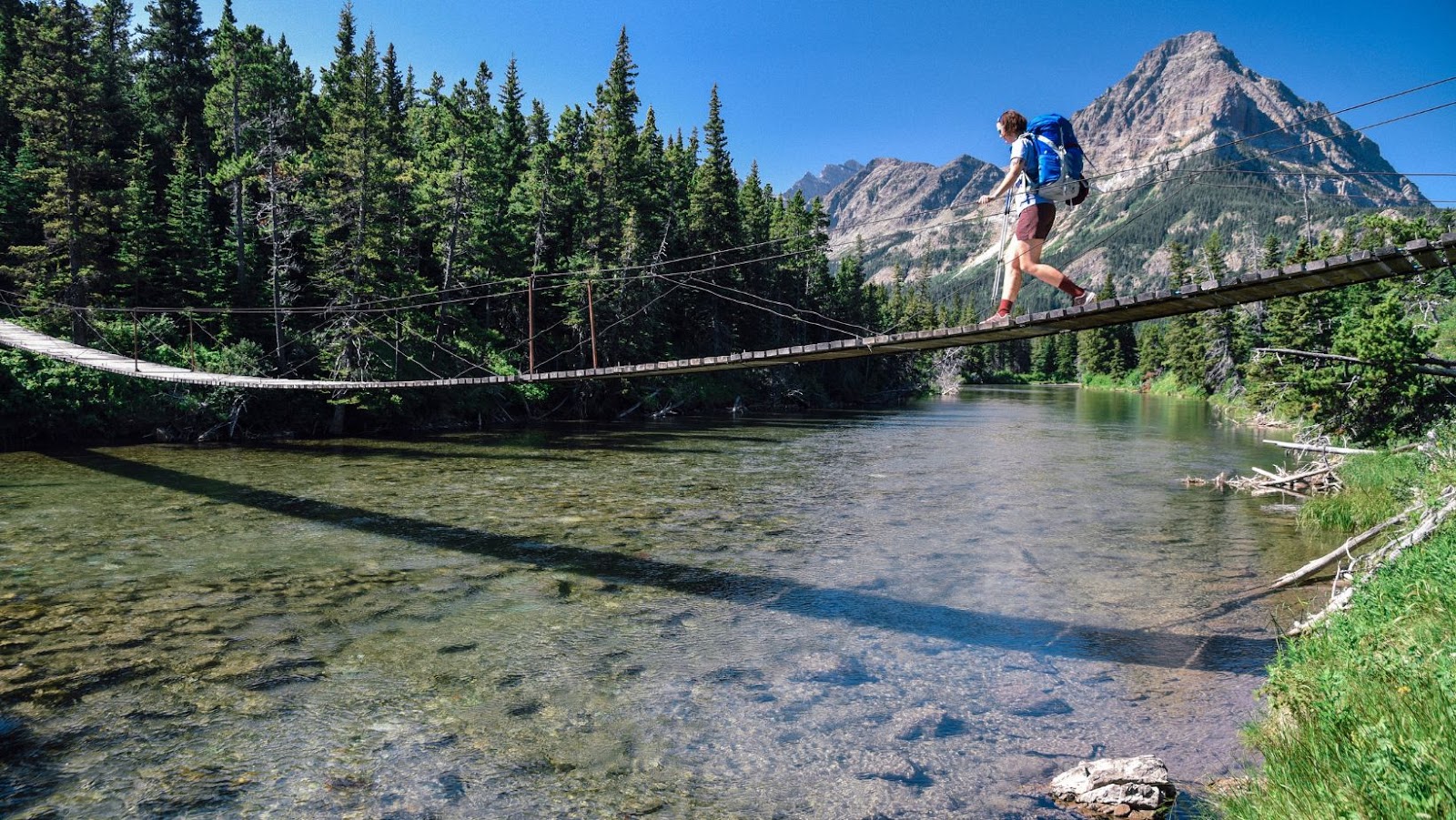
Introduction
Glacier National Park, established in 1910 and encompasses over one million acres of rugged alpine terrain in northwestern Montana. Home to a diverse range of wildlife, the park consists of deep glaciated valleys and mountain peaks that soar to elevations above 10,000 feet. Boasting spectacularly pristine views from its high mountain ridges, Glacier National Park is an outdoor enthusiast’s playground.
The park holds 26 named glaciers that support an array of breathtaking landscapes including majestic mountains, wildflower meadows and glacier-fed alpine lakes. These features offer visitors an opportunity to experience the vibrant wildlife and visually stunning backcountry of Glacier National Park.
Opportunities abound for recreation along the 700 miles of trails where visitors can observe diverse flora and fauna, savor the vibrant colors at sunrise or watch deer or bears roam through meadows near evening campfires. Popular activities include:
- Hiking
- Camping
- Cross-country skiing in winter months
- Fishing in pristine glacial streams all year round.
The present day Glacier National Park encompasses numerous plant habitats ranging from open grasslands to dense forests, lakes carved by glaciers to mountain tops where cold temperatures permit only sparse vegetation growth. Hundreds of species fill the air with song from migratory birds during springtime movements throughout this region which serves as a critical corridor for avian populations during these journeys each year.
History
Glacier National Park has a long and vibrant history. The area has been inhabited by humans since the last ice age, when Native American tribes moved in and carved out a living in the rugged landscape. Over time, the area became a hot spot for hikers, climbers and nature lovers, until it was designated a National Park by the US Congress in 1910.
Nowadays, Glacier National Park is a popular destination for tourists and outdoor adventurers alike, who come to experience the wonders of nature and explore the area’s diverse wildlife and ecosystems.
Pre-Glacial History
Glacier National Park’s pre-glacial history is rich, but there is a lack of documented evidence due to the glacial activity. The park boasts of pictographs found in many caves throughout the area that are believed to belong to regional Native American tribes. The exposed mountain surfaces also show evidence of river gorges, steep escarpments and glacial sculpting from previously glaciated mountains.
Geologists believe that Glacier National Park has been the victim of four separate glaciations during the last two million years. During these four cycles, glaciers carved valleys into the mountainous regions and deposited sedimentary rocks on top of much older underlying rocks from 1.6 billion years ago. This resulted in dramatic rocky peaks and chains, as well as thick blanket of soil for vegetation to sprout up from after the glaciers receded about 10,000 years ago. Different plants began thriving at various altitudes made possible by this special topography ranging from douglas fir to alpine flowers such as western columbine and glacier lilies growing between 9,000 and 11,000 feet in elevation. Notably too are numerous small lakes left behind by receding glaciers that serve as important refuges for fish such as cutthroat trout.
Evidence of human existence in Glacier National Park dates back 12000 to 13500 years ago when Paleo Indians occupied over 300 sites within its boundaries consisting mostly hunting campsites used seasonally during migration patterns then eventually replaced by Non-nomadic Indigenous tribes that uses it primarily for hunting and collecting food resources such as berries along with fishing in rivers like South Fork Flathead River which empties out into lake McDonald. Later is presence began diminishing due to conflicts with European settlers who were at odds vying shared resources or their land claims eventually resulting their complete displacement from the area by late 1800s beginning new phase for present day Glacier National Park’s development with notable historical events including Birth of preservationist movements spearheaded influential groups such explorers club as well activism lead Pope & Talbot lumber company leading way first organized group recreational event through Annual Roundups bringing attention idea resort destination public fueling increased interest what later became US Congress carving out region 1891 expanding size 1905 leading ultimate stand alone designation 1913 uniting successive conservation efforts together creating America’s first international peace park reaching next level protection thru border sharing framework including Waterton Lakes national park across Canadian side 1910 further solidifying region reputation impressive natural landscapes continued long lasting protection managed nowadays by both agencies across both country borders.
Glacier Formation
Glacier National Park was formed about 150 million years ago due to the collision of two tectonic plates, which created the Rocky Mountains. While there was likely ice present in periods in the park’s past, it wasn’t until several thousand years ago when snow began to pile up and form what we now call glaciers. This slow-moving river of ice has sculpted the landscape of Glacier National Park in many ways and is responsible for features like U-shaped valleys and horns which are formed by alpine glaciers.
The glaciers first became visible around 12,500 years ago as a result of a period known as the Wisconsin glaciation. During its peak, this period saw an ice sheet up to 2 miles thick covering most of North America so far south as Chicago and New York City! This glacier melted away around 10,000 years ago and left behind vast fields of moraines made up of rocks and boulders pushed aside by the huge pieces of ice.
These large fields were surrounded by more mountainous locations that had been carved out by active glaciers. By 1850, over 150 individual glaciers were identified within what is now known as Glacier National Park. Unfortunately due to climate change these numbers have decreased dramatically since then; today only 25 remain in an area that spans over 1 million acres! As time goes on even fewer will survive but they will still offer visitors unique opportunities to explore alpine landscapes untouched by humans.
Current State
Glacier National Park is one of the crown jewels of Montana, located in the northern Rocky Mountains. While it is a place of unparalleled beauty and recreation opportunities, the park is not static – it is constantly changing and evolving.
The present day Glacier National Park is home to a diverse array of wildlife, geological features and habitats, as well as a powerful force of natural processes. Let’s take a closer look at the current state of Glacier National Park.
Location
Glacier National Park is located in Montana, United States and spans the Continental Divide between Canada and the United States. The park is centered around Glacier Bay, a long narrow bay stretching from northwest to east over a distance of about 20 miles. The southern section of Glacier National Park lies in Flathead County on the northeastern edge of western Montana, while the northern portion extends into Albert Country on the extreme southwestern edge of Alberta.
The area surrounding Glacier National Park is incredibly diverse in terms of its topography, habitat and species richness. The Rocky Mountain Front ranges from alpine regions near Logan Pass to lodgepole forests at higher elevations that provide important habitat for grizzly bears, elk and other large mammals. Aspen forests fringe mountainsides at lower elevations while subalpine meadows are home to mountain goats and bighorn sheep. It’s also home to some of the most spectacular scenery in North America including:
- glacier-carved valleys;
- towering mountain peaks (including Mount Cleveland – 10452 ft (3189 m)); and
- stunning waterways carved by ancient glaciers.
Size and Climate
Located in the U.S. state of Montana, Glacier National Park spans more than 1 million acres and includes parts of two mountain ranges, over 130 named lakes, and more than 1,000 different species of plants. The park’s meadows and mountains, lakes and forests are some of the most beautiful creations nature has to offer.
The diverse climate of Glacier National Park means that temperatures vary greatly from one part of the park to the next. Summers are generally warm with cool evenings while winters can be cold with temperatures dipping below freezing at night. In summer months visitors should expect anywhere from 24-88 degrees F during daytime hours, while winter brings temperatures as low as 0 degrees F with cold winds.
Precipitation in Glacier National Park varies widely depending on location within the park. Annual precipitation amounts range from more than 50 inches along mountain peaks to less than 15 inches in some lower elevation locations like beside Lake McDonald Lodge or Apgar Village near the boundaries of Glacier National Park. Average snowfall during winter months is approximately 70 inches. So, come prepared for sometimes considerable variations in weather within Glacier National Park!
Flora and Fauna
Glacier National Park is best known for its unique combination of glacial-carved terrain, extensive high country meadows, and pristine mountain lakes. The park is home to an abundance of flora and fauna, with numerous species that are rare or unique to certain parts of the park. An abundant variety of wildflowers can be found among the valley floors and forested peaks during the late spring and early summer months. Wild blueberry patches are plentiful in some areas, adding a splash of bright color to the meadows and wetlands.
There is an exceptionally diverse assortment of mammals in Glacier National Park. Among them include woodland caribou, wolverines, moose, mountain goats, bighorn sheep, black bears, grizzly bears, lynx bobcat and wolves can also be seen in small numbers throughout the park’s more remote regions.
Bird watchers have plenty to spot as well; over 200 species have been identified since Glacier Park was established in 1910 – including the iconic ospreys which make their nests along turbulent rivers like those that flow out from the valley’s many glacier-carved lakes.
With over 1 million acres to explore, adventurers will find something new each time they step foot into this priceless national treasure.
Activities
Glacier National Park is an outdoor lover’s paradise with an abundance of activities to do from exploring waterfalls and hiking trails, to rafting through the valleys. No matter which activity you choose, the sights and experiences of Glacier National Park will leave you captivated.
From biking to boating, and fishing, to camping, Glacier National Park has something for everyone:
- Biking
- Boating
- Fishing
- Camping
Hiking
Glacier National Park is a hiker’s paradise, with over 700 miles of trails that traverse alpine meadows, frame stunning lake vistas and lead to rugged peak summits. Opportunities for all ages and abilities include easygoing nature walks and leisurely day hikes, as well as challenging backcountry treks and rigorous peak bagging quests.
The park offers more than 100 established trails ranging from easily-accessible flat routes like the Hidden Lake Trail at Logan Pass to grueling multiday hikes such as the Highline Trail between Logan Pass and Many Glacier. When hiking in Glacier it’s important to carry plenty of water and food, tell someone where you’re going, choose an appropriate route for your level of experience, check trail warnings before you head out, never hike alone and stay on the trail whenever possible.
Popular trails within the park include:
- Grinnell Glacier Trail (7.6 miles one way/4-8 hours)
- Iceberg Lake Trail (9.7 miles one way/5-8 hours)
- Highline Trail (11 mile one way/ 10+ hours)
- Gunsight Pass Trail (15.7 miles/ 7 – 10.5 hours )
- Siyeh Pass Loop (10 miles / 5 – 8 hours )
Camping
Glacier National Park offers a variety of camping experiences in which visitors can explore the natural wonders of the park. Visitors have the option to establish a tent at designated campgrounds, park their RVs for a more comfortable stay or hike into one of the wilderness areas and set up their base camp at one of several primitive sites.
Campers should note that many campgrounds fill quickly and reservations are recommended from mid-June through Labor Day. All park campgrounds are open from late May to early October and accept RVs, trailers and tents alike. The Blackfeet Nation’s Badger Two Medicine Tribal Conservation Area (BCA) also allows for some primitive camping in BCA lands, but permits are required for both vehicles and campers and must be acquired beforehand through the Blackfeet Tribal Office.
Reservations can easily be made online prior to arrival or by calling 855.724.4737 during operating hours (7:00 am–9:30 pm MST daily). In order to keep bear interactions to a minimum, all food storage facilities in Glacier National Park must be bear-resistant. To reserve a campsite with food storage lockers instead of hanging ones provided by backcountry administrators, call 855.728.3337 between April 1st through September 30th only.*
*North Fork Flathead River paddle trips may launch at any time during the season using Hang Bear Lockers provided by backcountry administrators along with an orientation about human-bear relationships; please contact your backcountry administrator for more details about these type special permits/permits not available online or via phone reservations system, but in person at Glacier National Park headquarters in Montana or St Mary Visitor Center locations near entrance gates only.
Sightseeing
Glacier National Park is a paradise for sightseers, providing breathtaking views and diverse wildlife. From its icy glaciers, ancient mountains and colorful meadows to the views of its majestic rugged peaks, Glacier National Park has something for everyone.
Take a scenic drive along Going-to-the-Sun Road to explore the Park’s stunning panoramic views. Visit one of Glacier’s two visitor centers in Apgar or St. Mary’s and ask a ranger what wildlife you may encounter during your stay in Glacier National Park. Explore trails around lakes or up one of its lush mountain passes, wander through wildflower meadows, or view wildlife from one of the many easy interpretive walking trails winding along creeks and glacial valleys.
For those who prefer to be on the water, take a leisurely float trip down Flathead River or explore mountain lakes in a canoe. Lake McDonald and Bowman Lake are popular destinations for SUP boarders looking for tranquil reflections off still waters leading into distant mountains. For an adventure on whitewater rapids, jump onto the river at various points along the Middle Fork of the Flathead River!
Wildlife Viewing
Glacier National Park is a wildlife lover’s paradise. With its abundance of diverse terrain and habitats, visitors can get up close and personal with the variety of species that call this Montana park home. There are more than 70 species of mammals, including grizzly bears, wolverines, coyotes and bighorn sheep along with hundreds of species of birds ranging from owls to eagles.
In the summer months, you can watch bighorn rams battle for dominance as they look for mating partners or experience the majestic beauty of snow geese honking in joy during their flight south. Visitors may also possibly catch glimpses of mountain goats scaling near impossible courses on rocky slopes or spot otters sliding into still waterholes in search of food. Other wildlife viewing activities include elk bugling during fall mating season, moose feasting on aquatic vegetation at the edge of a lake or even female grizzly bears teaching their cubs critical survival skills.
Guided ranger hikes within Glacier National Park allow visitors to go deep into areas that often have higher probability for wildlife viewing opportunities. For those interested in off-trail adventures, permits are occasionally issued for expeditions within the park’s boundaries upon obtaining approval from park rangers. The rewards for such ventures are often breathtaking experiences with spectacular displays of nature’s most beautiful creatures.

Time Zone
Glacier National Park is located in the state of Montana and is bordered by Canada to the North. The park is situated in the Mountain Time Zone, meaning the time is set seven hours behind the Universal Coordinated Time (UTC-7). The region observes daylight savings time in the summer, which is UTC-6. Knowing the time zone in Glacier National Park is important for visitors who plan to do activities during the day or evening.
What Time Is It In Glacier National Park?
Glacier National Park in Montana is located in the Pacific Time Zone and observes daylight saving time. During Daylight Saving Time, the park is on Pacific Daylight Time (PDT), which is seven hours behind Coordinated Universal Time (UTC -7). This means that when it is 12:00 UTC, it is 5 a.m. PDT in Glacier National Park, 8 a.m. Eastern Standard Time (EST -5), 7 a.m. Central Standard Time (CST -6), 6 a.m. Mountain Standard Time (MST -7), and 4 a.m. Alaska Standard Time (AKST -9).
When Daylight Saving Time isn’t being observed, the park is on Pacific Standard time (PST), which is eight hours behind UTC and one hour ahead of EST/CST/MST/AKST timers in the winter months.
Time Difference From Other Locations
Glacier National Park is located in the U.S. state of Montana and spans two time zones: Mountain Daylight Time (MDT) and Pacific Daylight Time (PDT). The park’s borders run along the crest of the Continental Divide, with one side in MDT and the other in PDT. It is important to be mindful of time zone differences, especially when traveling across state lines or internationally.
Glacier National Park is 3 hours behind Coordinated Universal Time (UTC) when on MDT and 2 hours behind UTC when on PDT. This means that if it is 10:00 UTC or 11:00 AM Central European Summer Time (CEST), then in Glacier National Park it will be 7:00 AM MDT/PDT depending on which side you are traveling on.
The time difference between Glacier National Park and its neighboring states is:
- 1 hour ahead of Idaho, Wyoming and South Dakota;
- 1 hour behind Alberta Canada;
- 2 hours ahead of Washington;
- 3 hours behind Montana on its eastern border;
- 4 hours behind Colorado;
- 4½hours ahead of North Dakota;
- 5 hours ahead of Nebraska ;
- 6½hours behind New Mexico and Arizona;
- 7½hours ahead of Oklahoma ;
- 8½ahead of Texas;
- 9-10 ahead of Louisiana , Mississippi , Alabama and Georgia ;
- 11 hours ahead of Florida , Tennessee , Virginia & North Carolina ;
- 13 hours ahead of New York ;
- 14 hours ahead of Massachusetts & Connecticut .
In addition, local jurisdictions may also have their own daylight savings time rules within individual states which will affect the above mentioned differences from each locality as well as from other countries around the world such as Europe, Japan, China & India . It is advisable to check local specific regulations before traveling so as not to be caught by surprise.
Conclusion
In conclusion, the present-day Glacier National Park is a beautiful wilderness area that is remarkably well-preserved. Formed thousands of years ago, this unique mountain landscape provides a wide variety of activities and amenities for people of all ages and interests. From breathtaking views to fantastic wildlife, Glacier has something for everyone. Additionally, as an area managed by the National Park Service, Glacier provides a safe place to explore and appreciate nature.
Thanks to ongoing conservation efforts, we can be sure that generations to come will continue to be able to enjoy the beauty of Glacier National Park for many years to come.





